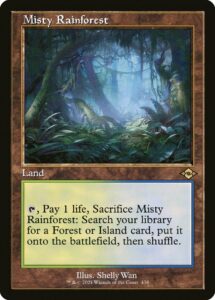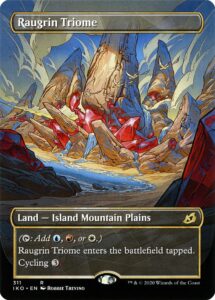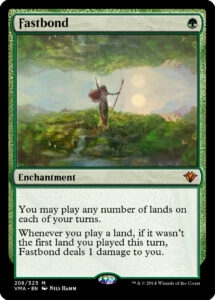Over the past few months, I have loved being back on Magic Online. I cannot get enough of Double Masters 2022, a set which is almost completely unavailable to play in paper one week post release, yet thanks to MTGO I’ve drafted it over 20 times! But perhaps more importantly, it has Cube! Last month, I had the pleasure of not only drafting the Vintage Cube a bunch of times, but doing so on stream, something I’ve barely done since 2014 (back when I think it was still called the Holiday Cube).
Magic Online’s Powered Cube is certainly in a different place than it was eight or so years ago. Sure, the classics are all there—the Power Nine, Sol Ring, Library of Alexandria, Strip Mine, even the relative youngsters like Upheaval, Skullclamp, and Jace, the Mind Sculptor—but much has changed and is worth discussion. But rather than a macro-level view of how creatures are stronger, threats are cheaper, and white aggro has become ascendant, let’s focus in on just ten cards to see specific changes in action. Ten of my very favorite cards, to be precise: the Onslaught and Zendikar fetchlands.

Scarcity begets necessity
When I draft cube, I love drafting decks that would just get wrecked by Ruination and Blood Moon. I love drafting 4-5 colors. I love having more consistent mana than my opponents with insufficient dual lands in their two-color decks. I love being able to pick up unwanted finishers in pack three and play them, no matter what their colors are. In short, I love drafting nonbasic lands, and none of them are better than the fetchlands.
Fetchlands magnify the value of every dual land you have access to. They minimize the awkwardness of splash colors (by making you need to run very far actual sources of those colors) and provide mostly untapped sources of mana on demand. On top of all that, they have plenty of additional applications with cards like Brainstorm, Courser of Kruphix, Crucible of Worlds, and Treasure Cruise.
Back in 2014, the support for fetchlands was fairly minimal. Wizards had printed only twenty dual lands with basic land types: the dual lands (like Tropical Island) and the strictly-worse Shocklands (like Breeding Pool). With a small pool of both fetchlands and fetchable lands, both were high priority pickups. There simply was no redundancy with fetchlands and minimal redundancy with fetchable nonbasics. If you wanted to assemble a strong fetchland manabase, you had to draft both fetchlands and dual lands very highly to ensure that you had enough of both and that your fetchlands could find your dual lands.

Redundancy in action
Now the calculus is different. Magic hasn’t only added more fetchable dual lands in Battle for Zendikar, Amonkhet, and even Kaldheim, it’s introduced fetchable tri-lands in Ikoria: Lair of Behemoths and Streets of New Capenna. With those tri-lands added to the Vintage Cube, there are now thirty fetchable nonbasic lands. Fetchable lands are now less valuable as there are 50% more of them (and some, like Jetmir’s Garden, are useless to the aggressive decks that would like a Plateau or Sacred Foundry). The Alpha duals are still the strongest, but the tri-lands have added affordances, as Raugrin Triome can be found with Marsh Flats, unlike Volcanic Island.
A higher density of fetchable lands adds value to the fetchlands. With so many targets floating around the cube, your fetchlands are far more likely to be able to fix your mana. That would already be the case just by adding Battle for Zendikar Tango lands or Amonkhet Cycling lands, but every tri-land can be found by nine of the ten fetchlands (as opposed to dual lands, which can be found by seven). For even marginally greedy decks, this makes every fetchland far more desirable.
Now, I still first pick fetchlands, but I’m far more likely to grab an Arid Mesa or Wooded Foothills early. I’m also far less likely to speculate on an early Bayou when there are so many redundant sources of black and green. And, I also prioritize early interaction more highly, both because there are more potent aggressive decks and the trilands can slow my decks down.

It may not surprise you that creating redundancy in fetchable lands adds pressure, value, and scarcity to fetchlands. When A and B have a symbiotic relationship and you increase the supply of B by 50% without adjusting the amount of A, you’re going to affect the demand for and efficacy of A. It’s been fun seeing this effect in action, modifying my draft heuristics, and seeing the ripple effects it causes (like how I now value cheap interaction higher and am even more greedy with my manabases).
It’s wonderful how long-lived Magic is, as we can see the game shift both dramatically and slowly over time, even in its most powerful Limited environments. Fetchlands’ function in Vintage Cube is just one branch of the massive tree of Magic, and just this one branch is intertwined with many, many discussions. Do fetchlands do more harm than good? (Short answer: probably. They restrict the possibility space of dual lands and adds lots of shuffling to paper.) Would Vintage Cube be better with a ten card cycle of Bad Rivers? (Probably not, they’re very weak.) Should the cube break singleton and double up on fetchlands? (Yes, but only once. Many people are very attached to singleton in Cube.) But those are all questions are for other days. For now, I’m happy jamming as many fetchlands as I can into every one of my cube decks. With Cube Con approaching in a few months, I’ll have plenty of opportunities to continue this trend. And of course, I’m looking forward to the next lessons I learn as the formats continue to change over time.
Zachary Barash is a New York City-based game designer and the last commissioner of Team Draft League. He designs for Kingdom Death: Monster, has a Game Design MFA from the NYU Game Center, and does freelance game design. When the stars align, he streams Magic (but the stars align way less often than he’d like).

